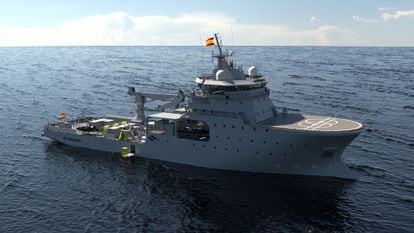Spanish navy’s newest project: a submarine rescue ship to protect underwater treasure
The vessel, which has finally been given the green light by the Finance Ministry, will be able to locate shipwrecks off the coast and salvage wreckage from airplane crashes


Spain has invested €3.9 billion on a new S-80 submarine, but does not have a ship capable of rescuing it. If there were to be a disaster like the one that sunk the Russian sub Kursk in 2000 or Argentina’s Ara San Juan in 2017, Spain would have no proper way of helping the 40-strong crew. To address this problem, the Spanish government has authorized the construction of a new submarine rescue ship, but it will not be ready before 2024.
The only rescue vessel the Spanish navy currently has is the Neptune (A-20), a 45-year-old antique that has not been decommissioned yet because it is still needed for scuba practice. Among its many limitations, the Neptune cannot board a rescue vehicle or a remote-controlled one, nor can it remain in a fixed spot (to supply oxygen, water and food to a sunken submarine) unless it is able to deploy its four anchors. For it to be able to do this, sea conditions have to be good and the sea bed cannot be at a depth of more than 50 to 80 meters. The maximum depth that an S-80 sub can operate in during peace times is 350 meters – the depth at war is a military secret.
Unlike the ‘Neptune,’ the new ship will be able to remain at a fixed point regardless of whether there is rough sea or the depth of the sea bed
For years, the Spanish navy has been calling for the construction of a Military Action Ship for Underwater Intervention (BAM IS), and the Finance Ministry finally agreed to it last July. The Defense Ministry has included the proposal in its budget for 2021, allocating €167 million (€53.4 million in 2021) to the BAM IS and another €25 million for equipment purchases.
Unlike the Neptune, the BAM IS will be able to remain fixed at any point in the ocean, regardless of how deep the sea bed is or whether there is rough sea. This is thanks to its dynamic positioning system, which manages five electric engines.
The vessel will feature a side-scan radar, two hyperbaric chambers, two remotely-operated underwater vehicles (ROVs), two underwater communication systems, emergency supply systems and a helipad to evacuate the injured and receive supplies. It is based on the Meteoro-class offshore patrol vessel design the Spanish navy already operates, but features a higher tonnage (5,000 tons compared to 2,670) and double decks.
The BAM IS will be used to rescue stricken submarines, but that will not be its only job. Wrecked fishing ships or airplane and helicopter crashes at sea are more common than submarine accidents. Recovering the bodies of fallen crews for humanitarian reasons, and the wreckage from fallen aircraft to investigate the cause of the accident, will be much easier with a vessel that can operate at great depth.
The navy also aims to use the BAM IS to support underwater operations, such as deactivating underwater bombs and removing or placing obstacles.
Another important task, aside from its military uses, will be to protect Spain’s underwater cultural heritage. The ROVs on the ship, which can be guided by cable and are equipped with cameras, will be able to identify and scan for shipwrecks off the Spanish coast.
Being able to locate and survey these shipwrecks will help avoid a repeat of what happened to the frigate Nuestra Señora de las Mercedes, whose treasure was raided by US-based company Odyssey Marine Exploration in 2007. It was not until 2012, after a protracted legal battle, that the US Supreme Court ordered the company to return the 594,000 silver and gold coins it took from the shipwreck to Spain.
Once the building order is signed at the beginning of next year, construction on the new BAM IS will begin at the Navantia shipyard in Puerto Real in Cádiz province. It is expected to take 36 months to complete. According to the State Society of Industrial Participation (SEPI), the project will involve 1.3 million hours of work and create 1,115 direct and indirect jobs in Cádiz.
English version by Melissa Kitson.
/cloudfront-eu-central-1.images.arcpublishing.com/prisa/X3ZDNYACM5A4HJEDUII6OEJ7FU.jpg)










































